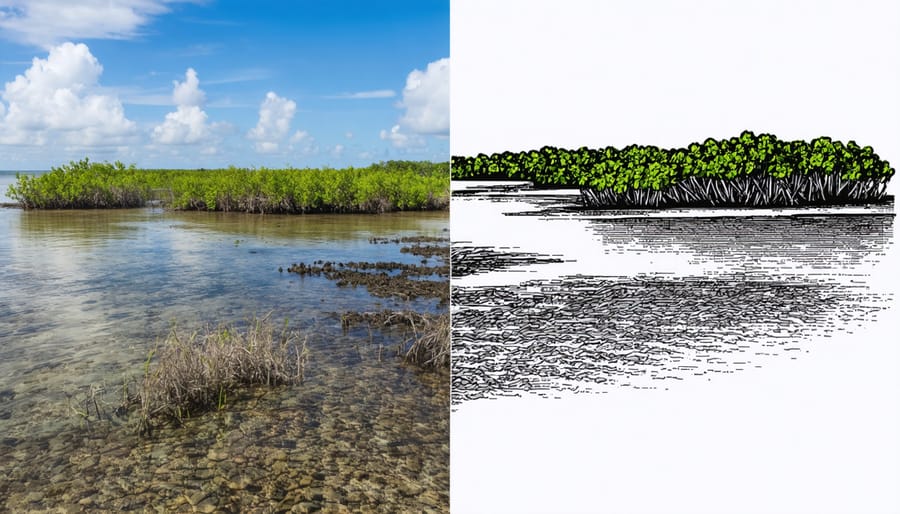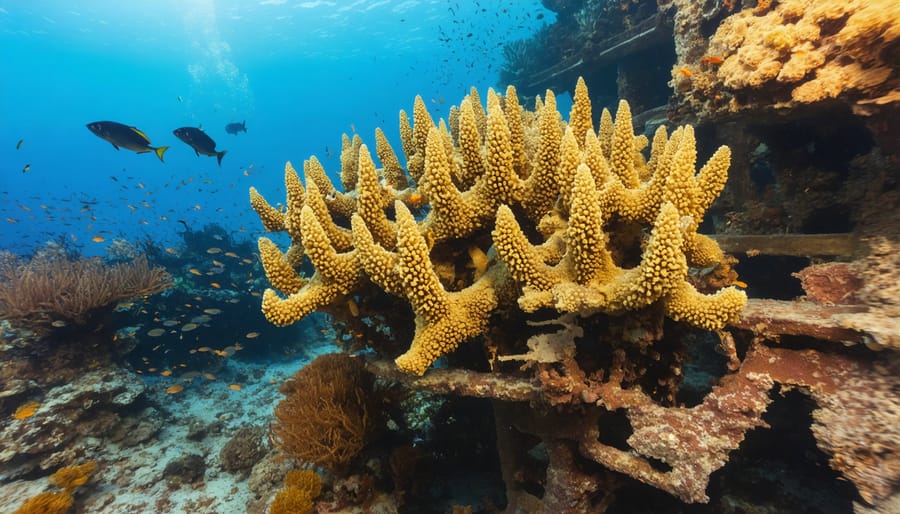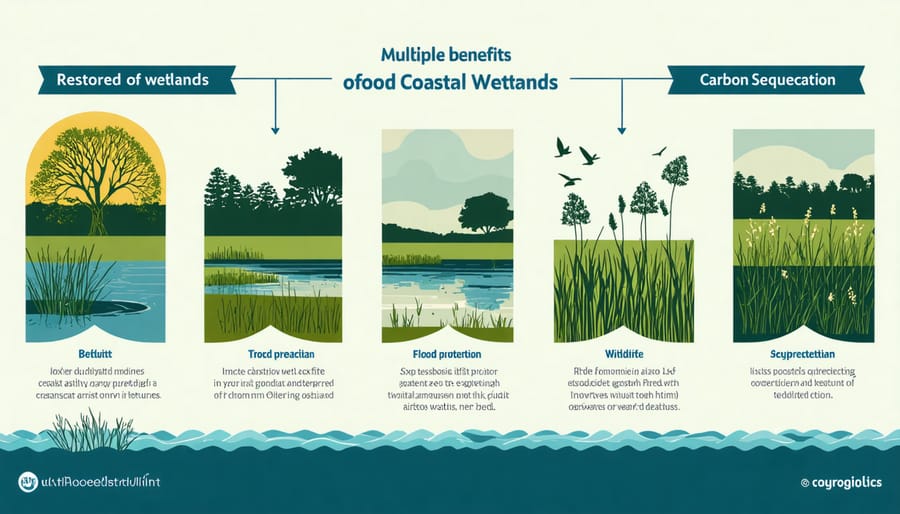
Habitat restoration stands as one of humanity’s most powerful tools in the fight to preserve Earth’s biodiversity and rebuild damaged ecosystems. When natural environments become degraded through human activity, climate change, or natural disasters, these vital spaces that support countless species can begin to collapse. Yet through careful scientific intervention and community dedication, we can revive these essential landscapes and return them to their former glory.
Imagine a damaged coral reef transformed into a vibrant underwater city, or a barren wetland restored to a thriving nursery for countless species. This is the promise of habitat restoration – a comprehensive approach that combines scientific expertise, community engagement, and natural processes to heal our planet’s wounded ecosystems. From replanting native vegetation and removing invasive species to reconstructing soil compositions and reestablishing natural water flows, restoration projects work to recreate the complex web of life that makes each habitat unique.
As our understanding of ecosystem dynamics grows, so does our ability to implement more effective restoration strategies. These efforts not only protect endangered species and enhance biodiversity but also provide crucial ecosystem services like flood protection, carbon sequestration, and water purification that benefit human communities worldwide.
What is Coastal Habitat Restoration?

Key Components of Restoration
Successful habitat restoration relies on several interconnected components working in harmony. Species reintroduction forms the cornerstone of many restoration projects, carefully bringing back native flora and fauna that once thrived in the area. This process requires extensive research to ensure the timing and conditions are optimal for species survival.
Substrate improvement focuses on enhancing the physical environment, whether it’s stabilizing shorelines, adding appropriate sediments, or creating structural complexity that supports marine life. In coral reef restoration, for instance, artificial reef structures provide the foundation for new coral growth and fish habitats.
Water quality management is crucial for long-term success. This involves monitoring and improving various parameters including temperature, salinity, oxygen levels, and nutrient content. Regular testing helps identify potential issues before they impact the restored ecosystem.
Other vital components include:
– Invasive species control
– Hydrological restoration
– Native vegetation establishment
– Monitoring and adaptive management
These elements must be carefully coordinated and maintained over time, often requiring collaboration between scientists, local communities, and government agencies. The success of restoration projects depends on addressing all these components systematically while remaining adaptable to changing conditions.
Types of Coastal Habitats
Coastal habitats encompass diverse ecosystems that serve as critical transition zones between land and sea. These dynamic environments include salt marshes, seagrass meadows, and mangrove coastal habitats, each playing a vital role in maintaining marine biodiversity and protecting shorelines. Coastal wetlands act as natural buffers against storms while filtering pollutants and providing nursery grounds for countless marine species.
Coral reefs form another crucial coastal habitat, supporting approximately 25% of all marine life despite covering less than 1% of the ocean floor. These underwater cities provide essential shelter and feeding grounds for thousands of species while protecting coastlines from wave action and erosion.
Estuaries, where rivers meet the sea, create unique brackish water environments that support specialized plant and animal communities. These productive ecosystems serve as critical feeding stops for migratory birds and breeding grounds for many fish species.
Dune systems and coastal grasslands form the terrestrial component of coastal habitats, stabilizing shorelines and supporting distinct plant and animal communities adapted to salt spray and shifting sands. Together, these interconnected habitats form a complex web of life requiring careful restoration and protection.
Restoration Techniques and Methods
Physical Restoration Methods
Physical restoration methods involve hands-on techniques that directly modify and improve degraded habitats. One of the most common approaches is replanting native species, whether it’s seagrasses in coastal areas or mangroves along shorelines. Marine biologists and volunteers work together in coral reef restoration projects, carefully transplanting coral fragments to rebuild damaged reefs.
Sediment management plays a crucial role in habitat restoration. This includes removing excess sediment that might smother marine life, stabilizing eroding shorelines, and recreating natural substrate conditions. Teams often use specialized equipment to dredge accumulated material or add appropriate sediment types to restore optimal conditions for native species.
Structural modifications form another essential component of physical restoration. This can involve installing artificial reef structures, creating tide pools, or modifying existing infrastructure to better support marine life. For example, installing reef balls or engineered structures provides immediate habitat for fish and invertebrates while natural systems recover.
In many cases, restoration projects combine multiple techniques. A typical coastal restoration might include:
– Removing invasive species
– Grading and contouring the shoreline
– Installing erosion control measures
– Planting native vegetation
– Creating wildlife corridors
– Installing monitoring equipment
Success in physical restoration requires careful planning, appropriate timing, and ongoing maintenance. Projects often start with pilot areas to test methods before scaling up to larger regions. Regular monitoring helps track progress and allows for adaptive management as conditions change.

Biological Restoration Approaches
Biological restoration approaches focus on reestablishing the living components of an ecosystem through carefully planned interventions. Species reintroduction stands as a cornerstone of these efforts, involving the strategic return of native species that have disappeared from their historical habitats. Marine biologists often begin with keystone species – organisms that have a disproportionate effect on their environment – such as sea otters in kelp forests or oysters in coastal waters.
Population management plays a crucial role in ensuring the success of reintroduced species. This includes monitoring population dynamics, genetic diversity, and reproductive success rates. Conservation teams implement breeding programs when necessary and create protective measures to shield vulnerable populations during their establishment phase. For instance, in seagrass restoration projects, scientists often fence off newly planted areas to protect them from grazing animals until they’re firmly established.
Ecosystem engineering represents another vital biological approach, where species that modify, maintain, or create habitats are strategically introduced or supported. Common examples include coral transplantation in reef restoration and the reestablishment of mangrove forests along tropical coastlines. These ecosystem engineers help create conditions that support the return of other species, creating a cascade of positive ecological changes.
Success in biological restoration requires careful consideration of species interactions and timing. Practitioners must account for predator-prey relationships, competition between species, and seasonal variations in environmental conditions. Many restoration projects now incorporate adaptive management strategies, allowing for adjustments based on monitoring results and ecosystem responses. This flexible approach helps ensure the long-term sustainability of restored habitats and their biological communities.
Building Coastal Resilience
Climate Change Adaptation
Habitat restoration plays a crucial role in implementing effective climate change adaptation strategies for coastal communities. As sea levels rise and extreme weather events become more frequent, restored habitats act as natural buffers against storm surges, flooding, and erosion. For example, healthy mangrove forests can reduce wave energy by up to 66%, protecting shorelines and coastal infrastructure.
These restoration projects also enhance carbon sequestration capabilities, with salt marshes and seagrass meadows storing carbon up to 40 times faster than tropical forests. This “blue carbon” storage helps mitigate climate change while simultaneously building resilience in coastal ecosystems.
Marine biologist Dr. Sarah Chen explains, “When we restore coastal habitats, we’re not just helping wildlife – we’re investing in natural infrastructure that protects our communities. A restored wetland can absorb floodwaters like a sponge, while healthy coral reefs break down wave energy before it reaches the shore.”
Restoration efforts are increasingly incorporating future climate projections into their design. This includes selecting plant species that can thrive in warmer conditions, creating elevation gradients that accommodate sea-level rise, and establishing migration corridors for species that need to move as conditions change. These forward-thinking approaches ensure that restored habitats remain resilient and continue providing essential ecosystem services as our climate evolves.
Community Benefits
Habitat restoration projects deliver significant social and economic benefits to coastal communities, extending far beyond environmental improvements. When coastal wetland ecosystems are restored, they create natural buffers that protect shoreline properties from storm surge and flooding, potentially saving communities millions in disaster recovery costs.
These projects often generate local employment opportunities, from initial restoration work to ongoing maintenance and monitoring activities. Commercial fishing communities benefit from increased fish populations in restored habitats, leading to more sustainable catches and improved economic stability. Tourism also tends to flourish in areas with healthy coastal ecosystems, as restored habitats attract wildlife enthusiasts, photographers, and recreational fishers.
Educational opportunities abound through restoration projects, providing hands-on learning experiences for students and community members. Local schools often partner with restoration initiatives, creating living laboratories where students can study ecology, biology, and environmental science in real-world settings.
The restoration process itself builds community cohesion as volunteers work together toward a common goal. Many successful projects have sparked the formation of local environmental stewardship groups, fostering long-term community engagement in conservation efforts. These initiatives also preserve cultural heritage, particularly in communities where traditional practices are closely tied to coastal resources and marine life.

Success Stories and Future Directions
Habitat restoration efforts worldwide have demonstrated remarkable success in reviving ecosystems and protecting biodiversity. The Chesapeake Bay restoration project stands as a shining example, where decades of coordinated efforts have resulted in the recovery of vital seagrass beds and oyster reefs. Since 2000, over 85,000 acres of seagrass have been restored, providing essential nursery grounds for numerous marine species.
In the Florida Keys, coral restoration initiatives have shown promising results through innovative techniques like coral gardening and fragmentation. The Coral Restoration Foundation has successfully planted over 100,000 corals on degraded reefs, with survival rates exceeding 80% in many locations. These efforts have not only rebuilt reef structures but have also enhanced local fish populations and coastal protection.
Emerging technologies are revolutionizing restoration practices. Drone mapping and artificial intelligence now enable precise monitoring of restoration sites, while 3D-printed reef structures provide custom-designed habitats for marine life. In Australia’s Great Barrier Reef, scientists are experimenting with heat-resistant coral species and automated reef restoration systems that can work continuously underwater.
Community-based restoration projects have proven particularly effective. In the Pacific Northwest, tribal communities have successfully restored salmon habitats by combining traditional ecological knowledge with modern conservation techniques. These projects have seen salmon populations increase by up to 50% in some restored streams.
Looking ahead, restoration practitioners are increasingly focusing on climate resilience. New approaches include developing “living shorelines” that can adapt to rising sea levels and creating corridor networks between habitats to facilitate species migration. The integration of blue carbon initiatives with restoration projects is also gaining traction, offering both ecological and climate mitigation benefits.
These success stories demonstrate that while habitat restoration is complex and challenging, it can yield significant positive outcomes when properly implemented and supported. The future of restoration lies in combining traditional knowledge with technological innovation while ensuring strong community involvement and long-term monitoring programs.
Coastal habitat restoration represents a vital pathway to healing our marine ecosystems and securing a sustainable future for both wildlife and coastal communities. Through the combined efforts of scientists, local communities, and dedicated volunteers, we’ve seen numerous success stories of restored wetlands, regenerated coral reefs, and revitalized mangrove forests. These achievements demonstrate that with proper planning, resources, and commitment, we can reverse environmental degradation and strengthen coastal resilience.
The journey of habitat restoration is ongoing, and every individual can play a meaningful role. Whether through volunteering at local restoration projects, supporting conservation organizations, or simply spreading awareness about the importance of coastal ecosystems, your contribution matters. Consider joining beach clean-ups, participating in citizen science programs, or supporting sustainable fishing practices in your community.
As climate change continues to impact our coastal regions, the need for habitat restoration becomes increasingly urgent. By working together, we can protect and restore these crucial ecosystems for future generations. The time to act is now – get involved, stay informed, and become part of the solution in preserving our precious coastal habitats.
jessica
Ava Singh is an environmental writer and marine sustainability advocate with a deep commitment to protecting the world's oceans and coastal communities. With a background in environmental policy and a passion for storytelling, Ava brings complex topics to life through clear, engaging content that educates and empowers readers. At the Marine Biodiversity & Sustainability Learning Center, Ava focuses on sharing impactful stories about community engagement, policy innovations, and conservation strategies. Her writing bridges the gap between science and the public, encouraging people to take part in preserving marine biodiversity. When she’s not writing, Ava collaborates with local initiatives to promote eco-conscious living and sustainable development, ensuring her work makes a difference both on the page and in the real world.
